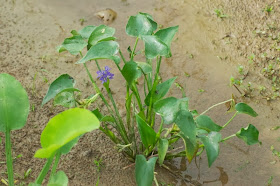The Pin-tailed Parrotfinches (Erythrura prasina) at Chupak continued to prove quite a draw. The following Tuesday, on September 3, 2013, I found myself heading for Chupak again – this time for a morning trip with Vincent Wong. The birds were still there, feeding in a patch of rice that was due to be harvested that very afternoon - to our considerable pleasure, if not that of the local villagers, whose bird-scaring banners continued to wave (with limited results) above the rice stalks.
Once again, I was only able to get some distant photographs, and none of the birds perched and feeding on the rice (which always seem to happen just out of sight).
These aren't great photos by any means, but at least they show the birds' colours.
Vincent, however, was determined to do better, and came prepared with tripod, powerful telephoto lens, and a portable blind where he spent a good hour – no mean feat in the growing heat of the day.
Unfortunately, the birds never came near him.
Unfortunately, the birds never came near him.
While Vincent sat sweltering in his hide, I took a stroll along the dikes between the paddies to see what else was around.
That included emergent water-plants. This looks something like Water-Hyacinth (Eichhornia crassipes) but I'm not at all sure that that is what it is.
That included emergent water-plants. This looks something like Water-Hyacinth (Eichhornia crassipes) but I'm not at all sure that that is what it is.
A knot of Pacific Golden Plovers (Pluvialis fulva) flew overhead, and unidentified (and probably unidentifiable) snipe, also in flight, passed by with a few Wood Sandpipers (Tringa glareola). These Intermediate Egrets (Egretta intermedia), though, were easier to photograph.
As the sun grew stronger, the birds grew quiet, the insects became more active, and I turned my attention to the local entemofauna. I watched fat black Giant Capenter Bees (Xylocopa latipes) trundle through the air from flower to flower.
A male Diplacodes trivialis posed on the pathway, where he was quite difficult to spot among the stones.
This dragonfly has a habit, on perching, of waving its wings back and forth - a bt like an old-fashioned biplane waving its wings in salute.
By contrast, this little dragonfly - though apparently not rare - was entirely new to me. It is a female of one of the most peculiar-looking of dragonflies, Acisoma panorpoides. Its peculiar, bottle-shaped abdomen is, at least among Malaysian dragonflies, unique.
This is an exuvium, the cast-off skin of a dragonfly nymph that has climbed out of the water, spread its wings, and is (by now) flying around the rice paddies somewhere. It appears to be the exuvium of a gomphid rather than, like the adult dragonflies in this post, a libellulid - the rounded abdomen and swollen, club-like antennae are characteristic. The only gomphid I have seen in Chupak is the common Ictinigomphus decoratus, so that is probably what this is.
I usually don't show corpses, but this - probably beheaded by one of the farmers, though in life it was a perfectly harmless creature - is the body of a quite interesting reptile. It is a Sunbeam Snake (Xenopeltis unicolor), one of only two species in the Asian family Xenopeltidae. Though it spends much of its life underground, emerging at night in search of frogs, mice and other snakes, its scales are highly iridescent (hence the name). One wonders why. Besides being beheaded by rice farmers, Sunbeam Snakes are victims - in large numbers - of both the skin and pet trades (in the latter case, despite the fact that they are difficult to keep).
I have often wondered what lives beneath the waters at Chupak, so these fish were particularly interesting. They are probably a species of Rasbora, perhaps the endemic R. sarawakensis although that is supposed to be a fish of rainforest streams. Outside Southeast Asia (and often enough within it) rasboras are "aquarium fishes", a designation that suggests that they evolved in glass tanks. It is usefulto be reminded that even aquarium fishes have, or had, a home in the wild somewhere.
I usually don't show corpses, but this - probably beheaded by one of the farmers, though in life it was a perfectly harmless creature - is the body of a quite interesting reptile. It is a Sunbeam Snake (Xenopeltis unicolor), one of only two species in the Asian family Xenopeltidae. Though it spends much of its life underground, emerging at night in search of frogs, mice and other snakes, its scales are highly iridescent (hence the name). One wonders why. Besides being beheaded by rice farmers, Sunbeam Snakes are victims - in large numbers - of both the skin and pet trades (in the latter case, despite the fact that they are difficult to keep).
I have often wondered what lives beneath the waters at Chupak, so these fish were particularly interesting. They are probably a species of Rasbora, perhaps the endemic R. sarawakensis although that is supposed to be a fish of rainforest streams. Outside Southeast Asia (and often enough within it) rasboras are "aquarium fishes", a designation that suggests that they evolved in glass tanks. It is usefulto be reminded that even aquarium fishes have, or had, a home in the wild somewhere.


+DSC_9584.jpg)
+DSC_9588.jpg)
+DSC_9592.jpg)
+DSC_9580.jpg)
+DSC_9581.jpg)




+DSC_9595.jpg)
+DSC_9596.jpg)
+DSC_9600.jpg)
+DSC_9622.jpg)
+DSC_9629.jpg)
+DSC_9635.jpg)
+DSC_9645.jpg)













+DSC_9717.jpg)





+DSC_9454.jpg)
+DSC_9466.jpg)
+DSC_9480.jpg)
+DSC_9450.jpg)
+DSC_9485.jpg)
+DSC_9457.jpg)
+DSC_9486.jpg)













+DSC_9523.jpg)
+DSC_9470.jpg)
+DSC_9570.jpg)